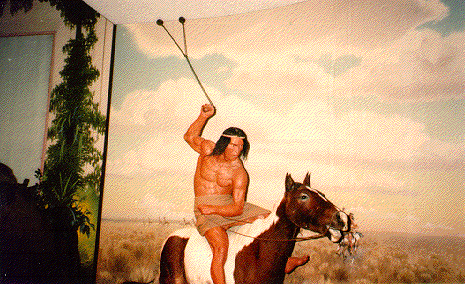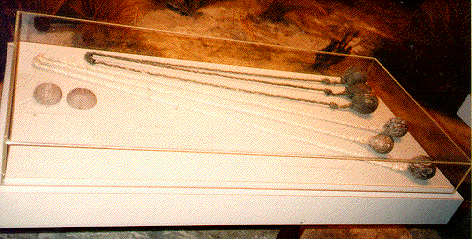|
The bola, or boleadora is a primitive hunting tool that was originally used by the Chinese, Eskimos and South American Indians. Bolas are a throwing device made of weights on the ends of interconnected cords, designed to capture animals by entangling their appendages (legs, wings). They are most famously used by the South American gauchos. Gauchos use bolas to capture running cattle or game. Depending on the exact design, the thrower grasps the bolas either by one of the weights or in the nexus of the cords. He gives the balls momentum by swinging them and then he releases the bolas. The bola is usually used to entangle the animal's legs, but if thrown with enough force, they have been known to break bones. There is no unique design. Most bolas have two or three balls, but there are versions of up to 8 balls. Some bolas have balls of equal weight, others vary the knot and cord. Bolas with three weights are usually designed with two shorter cords with heavier weights, and one longer cord with a light weight. The heavier weights flying at the front parallel to each other, hit either side of the legs, and the lighter weight going around, wrapping up the legs. Gauchos use bolas made of braided leather cords with wooden balls or small leather sacks filled with stones in the ends of the cords. Bolas can be named depending on the amount of weights used:
The bola perdida was primarily used against humans. The boleadoras is a tool for hunting Rheas (large flightless birds) or cimarrón (wild cattle). The bola perdida is an invention posterior to the arrival of horses, and it is used mainly in the Pampas and northern Patagonia. Tres Marias (Three Marys) or Tres Potreadoras (Three Tamers) usually had ropes of different lengths and weights of different mass so when thrown they would separate as much as possible. These were used for heavy animals like cattle. The Patagonian, Charruan, Araucan and the indians from las Pampas were the first to develop these tools and the gauchos promptly adopted them. Earliest examples were usually made of stone. The weights were usually covered in fresh leather that when dried would shrink to cover the weight snugly. In Tres Marias the smallest weight is called the "Manija". This is usually also hung on the shortest rope and is used to sling the boleadoras. The most luxurious boleadoras are made of ivory and covered in precious metals. The work on them may be so fine that they are actually considered works of art. Generally, there are three types of boleadoras weights:
The following information was provided by contributors who live in South America: From Lee Tonkasila: The ones I use to catch emus on my friends ranch have 3 leather bags full of steel shot and soft nylon braided 3/8 inch rope tied an equal distance (38 inches) from a central knot. I hold one ball in my left hand, swing the other two horizontal to the ground, and let the bola fly a little in front of the running bird. Just as I release the 2, I release the third with a slight flip to the right. They fly like a helicopter and will wrap up a 45 kg emu instantly. I don't know if I'm doing this right as I have never seen a Gaucho demonstrate, but I can catch a 35 mph emu without hurting him. Of course they aren't thrilled with the procedure. From Mariano Nucci: *In Argentina we call it "boleadora" (in Spanish language "bola" means "ball"). Our gauchos called it "las tres Marías" which means "the three Marys". Obviously, because there are three balls... And here, "the three Marys" are the three stars which make Orion's belt in the Orion Constellation. Beautiful stars and a beautiful name for a beautiful device. The gauchos learned to use the bolas from the indians. The gauchos used to use the bolas as a tool until the beginning of the 20th Century. Nowadays you can see the bolas only in museums or in traditional meetings where the gauchos wear their old clothes and the bolas are just an ornament. But in Patagonia, it is still possible to find ancient bolas spread on the field if you know where to look for them. Of course, picking them up is prohibited by Argentine laws. From Jesus Vega Hernandez of Argentina: Boleadoras is the more common expression for these devices, but the terms are more or less interchangeable. Anything with two or more weights is called a boleadora, or ocasionally bola. Ocasionally, each of the weights on a boleadora is called a bola. Using boleadoras (or bolas) is called 'bolear', and what you catch is 'boleado'. I have seen boleadoras of two and three weights. The two weights model was generally used to play, but have seen in museums too. The indians and matreros (outlaws) used the two weights type to break the telegraph lines. I passed many summers in the field with a cousin. The field keeper (the puestero) used part of a discarded grain sac to make two bags (roughly rectangles of 10 x 20 cm), filled them with gravel and tied with 1.5 metres of rope. It's a very simple boleadora, and it can be used to play with little risk (if you can avoid impacts on the head of your cousin, everything will be OK :-). If used near the house, you can put some grass inside the bag to soften the impact a little, or fill with grain. After the bags broke and without the possibility of repair (they lasted two weeks), I acquired a true boleadoras. It had three weights, made of stone wrapped in leather, each approximately 6 cm in diameter. Each cord was braided with 4 strips of cuero crudo (untanned leather), cured with horse manure, and roughly 1 metre in length each. I threw while riding, keeping one weight on the right hand and rolling the other two over the head. You must been cautious to synchronize and not touch the head of the horse (if the rope tangles around the horse's head, a bola can explode an eye, or your own head! I used these 4 or 5 summers (mostly for play. I've never been allowed to throw them at cattle), and keep them rolled on a wall while in city. Eventually, the leather broke when I tried to unroll it. The bola perdida has only one weight. It is a historic artifact. I have seen them only in museums and not in use. The first time I heard about the bola perdida was in a chapter of the TV series 'El Zorro', when a visiting gaucho used one to kill a neighbor in Los Angeles. It is said that the bola perdida was a later invention than the boleadora and was coincident with the arrival of horses. Before that, it is said that slings were used (simpler to made and carry, and were equally effective). |
|
Here are two Argentinian Postcards that show how the bola is thrown from horseback.

|
|
Back to: Flight Toys | Ethnographic Artifact Sales | contact: Ted Bailey


